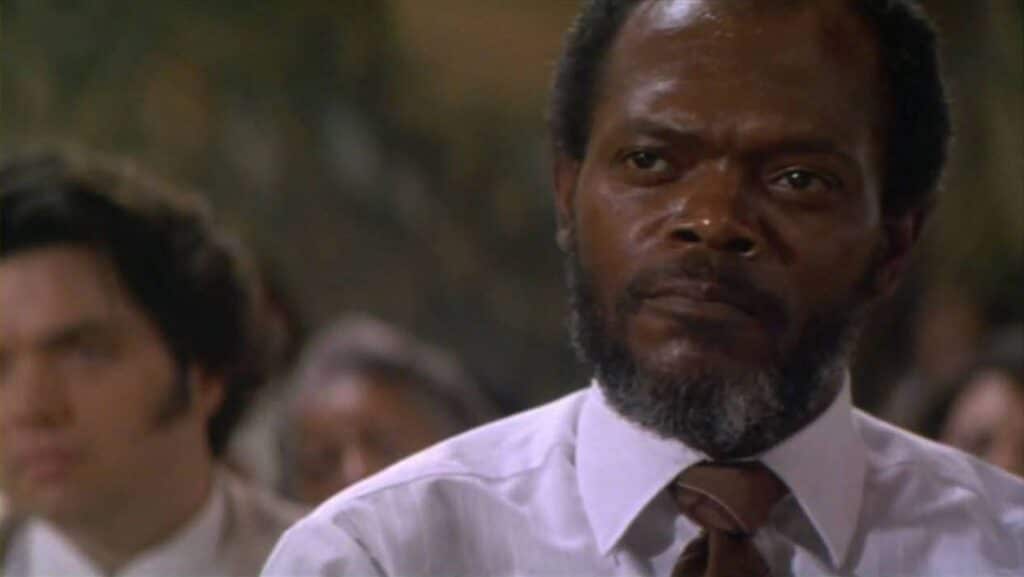Every month, we at The Spool select a filmmaker to explore in greater depth — their themes, their deeper concerns, how their works chart the history of cinema and the filmmaker’s own biography. For July, we honor the chameleonic genre-bending of the recently-passed Joel Schumacher, who embraced camp thrills and pulp trash in equal measure. Read the rest of our coverage here.
Watching Joel Schumacher’s A Time To Kill might be the closest thing to tearing through that un-put-down-able paperback beach read you picked up at the airport newsstand. With a stacked cast and a well executed script, it moves at an almost blinding pace for a courtroom drama. The performances are excellent, particularly those of Samuel L. Jackson as vengeful father Carl Lee Hailey and Matthew McConaughey—early in his career and full of Paul Newman-esque swagger—as beleaguered attorney Jake Brigance.
Schumacher doesn’t waste a second introducing the town of Canton, Mississippi (a town that seems to have outlawed air conditioners) before launching into the violent rape of a 10-year-old Tony Hailey (Rae’Ven Larrymore Kelly) by two hellraising good ol’ boys. The opening POV shots of the attack are effectively stomach-churning, cudgeling the audience with the suggestion that these are two men are irredeemable scoundrels.
It isn’t long before perpetrators Billy Ray Cobb (Nicky Katt) and Pete Willard (Doug Hutchison) are apprehended by police and subsequently gunned down by Tonya’s father, Carl Lee. Both men are killed and a deputy (Chris Cooper) is seriously injured in the process. Carl Lee’s defense is quickly scooped up by Brigance. It’s partly out of guilt for having some advance warning of the shooting, and it’s partly as an opportunity to step out of the shadow of his alcoholic mentor (Donald Sutherland). What follows is a strange, winding tale that unsuccessfully attempts to address the holes in the justice system marginalized people so often fall through.

For a film that tries so hard to make grand philosophical statements about race, it spends much of its time focused primarily on the white characters. We spend far more of the movie watching Jake with wife Carla (Ashley Judd), unpaid clerk Ellen Roark (Sandra Bullock), and slimy partner Harry Rex Vonner (an always delightful Oliver Platt) than we do with any of the Haileys. There’s also extensive time spent with the vindictive Freddie Lee Cobb (Kiefer Sutherland), brother of slain ne’er do well Billy Ray, who brings the KKK back to Canton with the help of Grand Dragon Stump Sisson (Kurtwood Smith).
The parts of A Time To Kill that feel the most real and immediate to a 2020 viewer are the clashes of protestors outside of the courthouse as the proceedings begin. There are fully robed Klan members going toe-to-toe with an entirely Black opposition, but it spends so little time on the just grievances of a community that is still being marginalized in the “New South.”
Don’t count on any nuance in the film’s depictions of race relations, either. Both sides are dumbed down and cartoonishly overdrawn (the presiding judge’s name is Noose, for chrissake). Instead, the movie delivers a billboard advertisement inviting the audience to visit Both Sides Have A Point-burg. Not even the sweaty veneer of Shumacher’s script can disguise John Grisham’s aggressively centrist political leanings. There’s even a baffling scene in which the film attempts to paint the NAACP in the same opportunistic light of Jake and his rival—slick, fast-talking D.A. Rufus Buckley (Kevin Spacey).
A Time to Kill shows very little legal work at all, but while Jake “works” to free Carl Lee, Freddie Lee antagonizes him in an escalating series of attacks. This culminates in the burning of Jake’s home and the assault of Ellen. Yes, women seem to have two purposes in this movie: to send men into a haze of vengeful fury or to nag Jake. In Ellen’s case, it’s both of the above. And just when Jake can see no good outcome short of a plea bargain, Carl Lee is there to dispense wisdom in a scene that falls just short of the Magical Negro trope.
For a film that tries so hard to make grand philosophical statements about race, it spends much of its time focused primarily on the white characters.
He tells Jake he hired him because he needed to make his enemy—the white man—work for him, because only a “bad guy” with a law degree can stop another bad guy with a law degree. If there’s any nugget of wisdom to be found in A Time To Kill, it’s that racism is so ingrained in white people they don’t even realize it’s there until someone points it out for them. “You can’t help it,” Carl Lee says patiently. “It’s how you was raised.”
In the end, white savior Jake prevails by using his closing statements to recount little Tonya’s assault in horrific, voyeuristic detail before dropping the mic with the ludicrous call to action: “Now, imagine she’s white.” Amazing. Racism is over now, right?
But while its flaws run deep as the Mississippi mud (maybe that’s just how it was raised), A Time To Kill is the best combination of courtroom drama and small-town thriller. You could say it’s Perry Mason’s dumber, flashier younger brother, but HBO seems to have that covered. Dumbed down as it is, A Time To Kill is still the kind of popcorn legal drama so indicative of the mid ‘90s it could almost be called comfort watching—if it weren’t so misguided.

